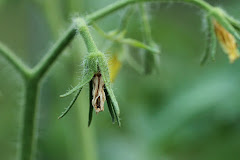 Chicory (Cichorium intybus) is an interesting garden vegetable that has many forms and is known by many names including frisee, curly leaf endive, flat leafed endive or escarole, radicchio, Belgium endive, witlof and chicon. Qriginally from Europe, chicory is a weed in America with scattered plants growing in Colorado at 4000 to 7000 feet elevation. Many people think it is a native “wildflower” (see photo). It is often confused with blue flax which has one layer of petals instead of the double “wheel” of chicory flowers.
Chicory (Cichorium intybus) is an interesting garden vegetable that has many forms and is known by many names including frisee, curly leaf endive, flat leafed endive or escarole, radicchio, Belgium endive, witlof and chicon. Qriginally from Europe, chicory is a weed in America with scattered plants growing in Colorado at 4000 to 7000 feet elevation. Many people think it is a native “wildflower” (see photo). It is often confused with blue flax which has one layer of petals instead of the double “wheel” of chicory flowers.Of the selected forms for eating, the leafy vegetables include frisee sometimes sold by seed companies as Cichorium endivia. The frilly leaves (see photo) are used as a bitter fresh green in salad mixes. Flat-leafed endive (escarole) is more often used as a wilted or cooked green. Note that some people use the term frisee for frilly lettuce but lettuce is in a whole separate genus, Lactuca. The chicory group of plants is confusing enough without mixing the idea of lettuces in with them.
 It’s entirely appropriate to be talking about frisee in late November as the greens are very cold hardy and can survive until early December particularly if mulched. Frisee is easy to grow in 45 days and can be planted in mid-summer for a fall crop, or in early spring as a cool season crop for harvesting before hot weather arrives. Some people blanch their crop by tying leaves in a bundle 3 days before harvest to deprive the inner leaves of light and change them to a light yellow color.
It’s entirely appropriate to be talking about frisee in late November as the greens are very cold hardy and can survive until early December particularly if mulched. Frisee is easy to grow in 45 days and can be planted in mid-summer for a fall crop, or in early spring as a cool season crop for harvesting before hot weather arrives. Some people blanch their crop by tying leaves in a bundle 3 days before harvest to deprive the inner leaves of light and change them to a light yellow color.Next post will be about another fun thing to do with chicory plants - harvest roots and force the gourmet witlof (chicon) buds to grow in winter.
Photo credits: Cichorium intybus flower-Alvesgaspar, Frisee – Frank C. Muller





